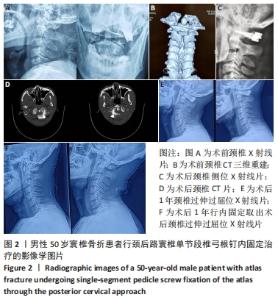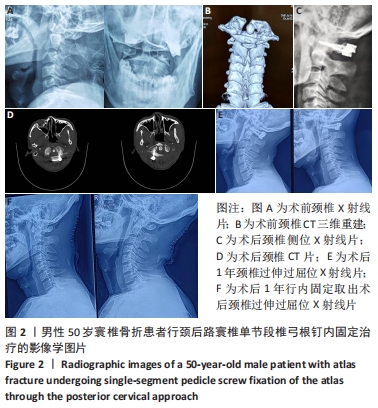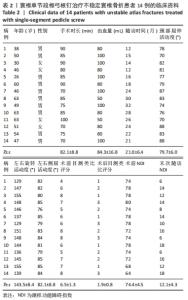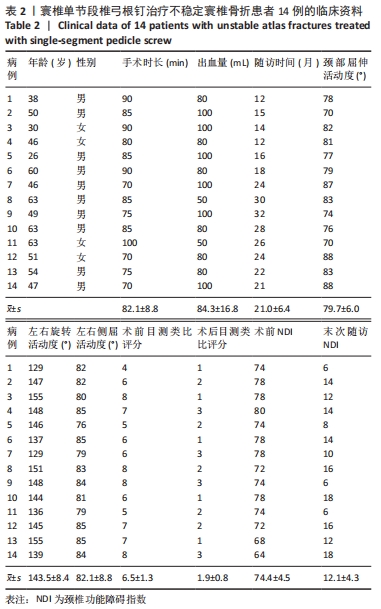Chinese Journal of Tissue Engineering Research ›› 2023, Vol. 27 ›› Issue (4): 594-599.doi: 10.12307/2022.986
Previous Articles Next Articles
Posterior single-segment pedicle screw fixation for unstable atlas fractures
Bao Kai, Song Wenhui, Liu Changwen, Liang Kaiheng, Wang Jiajia
- Department of Orthopedics, Second Hospital of Shanxi Medical University, Taiyuan 030001, Shanxi Province, China
-
Received:2021-12-14Accepted:2022-01-18Online:2023-02-08Published:2022-06-23 -
Contact:Song Wenhui, MD, Chief physician, Department of Orthopedics, Second Hospital of Shanxi Medical University, Taiyuan 030001, Shanxi Province, China -
About author:Bao Kai, Master candidate, Department of Orthopedics, Second Hospital of Shanxi Medical University, Taiyuan 030001, Shanxi Province, China
CLC Number:
Cite this article
Bao Kai, Song Wenhui, Liu Changwen, Liang Kaiheng, Wang Jiajia. Posterior single-segment pedicle screw fixation for unstable atlas fractures[J]. Chinese Journal of Tissue Engineering Research, 2023, 27(4): 594-599.
share this article
Add to citation manager EndNote|Reference Manager|ProCite|BibTeX|RefWorks

此项研究共纳入14例患者,手术时长平均(82.14±8.8) min,出血量平均(84.29±16.8)mL。所有患者平均随访(21.0±6.4)个月(12-32个月),术后复查颈椎X射线片及CT均可见内固定位置良好,复位良好。所有患者均未出现神经功能受损、椎动脉损伤、伤口感染等与手术相关的并发症。 目测类比评分由术前的(6.5±1.3)分降至术后的(1.9±0.8)分,差异有显著性意义(t=8.950,P < 0.05);NDI由术前的74.4±4.5降至末次随访时的12.1±4.3,差异有显著性意义(t=37.536,P < 0.05)。 末次随访时颈部屈伸70°-88°,平均(79.7±6.0)°;左右侧屈76°-85°,平均(82.1±2.8)°;左右旋转129°-155°,平均(143.5±8.4)°;颈部屈伸、旋转及侧屈均基本恢复正常水平,所有患者在最后一次随访时颈椎活动范围均恢复良好。术后4例患者主诉颈部僵硬伴活动受限,给予局部按摩、理疗等规范康复指导治疗下均基本恢复正常水平。术后随访时均无内固定松动或断裂等并发症发生。 2.4 典型病例 男性患者,50岁,诊断为“寰椎骨折”,于2020年7月在山西医科大学第二医院脊柱一组行颈后路寰椎单节段椎弓根钉内固定术,随访12个月,颈部活动度基本不受限,无伤口感染、内固定松动或断裂等不良事件发生,见图2。 "

| [1] IVANCIC PC. Plough fracture of the anterior arch of the atlas: a biomechanical investigation. Eur Spine J. 2014;23(11):2314-2320. [2] BODON G, GRIMM A, HIRT B, et al. Applied anatomy of screw placement via the posterior arch of the atlas and anatomy-based refinements of the technique. Eur J Orthop Surg Traumatol. 2016; 26(7):793-803. [3] WOODS RO, INCEOGLU S, AKPOLAT YT, et al. C1 Lateral Mass Displacement and Transverse Atlantal Ligament Failure in Jefferson’s Fracture: A Biomechanical Study of the “Rule of Spence”. Neurosurgery. 2018;82(2):226-231. [4] DVORAK MF, JOHNSON MG, BOYD M, et al. Long-term health-related quality of life outcomes following Jefferson-type burst fractures of the atlas. J Neurosurg Spine. 2005;2(4):411-417. [5] SCHLEICHER P, SCHOLZ M, KANDZIORA F, et al. Recommendations for the Diagnostic Testing and Therapy of Atlas Fractures. Z Orthop Unfall. 2019;157(5):566-573. [6] FIEDLER N, SPIEGL UJA, JARVERS JS, et al. Epidemiology and management of atlas fractures. Eur Spine J. 2020;29(10):2477-2483. [7] TESSITORE E, MOMJIAN A, PAYER M. Posterior reduction and fixation of an unstable Jefferson fracture with C1 lateral mass screws, C2 isthmus screws, and crosslink fixation: technical case report. Neurosurgery. 2008;63:E100-E101. [8] ZOU X, OUYANG B, MA X, et al. [Progress in treatment of unstable atlas fracture]. Zhongguo Xiu Fu Chong Jian Wai Ke Za Zhi. 2020;34(6):793-796. [9] SHATSKY J, BELLABARBA C, NGUYEN Q, et al. A retrospective review of fixation of C1 1 ring fractures—does the transverse atlantal ligament (TAL) really matter? Spine J. 2016;16(3):372-379. [10] HE B, YAN L, ZHAO Q, et al. Self-designed posterior atlas polyaxial lateral mass 4 screw-plate fixation for unstable atlas fracture. Spine J. 2014;14:2892-2896. [11] HU Y, XU RM, ALBERT TJ, et al. Function-preserving reduction and fixation of unstable Jefferson fractures using a C1 posterior limited construct. J Spinal Disord Tech. 2014;27(6):E219-225. [12] BEDNAR DA, ALMANSOORI KA. Solitary C1 Posterior Fixation for Unstable Isolated Atlas Fractures: Case Report and Systematic Review of the Literature. Global Spine J. 2016;6(4):375-382. [13] ZHANG YS, ZHANG JX, YANG QG, et al. Posterior osteosynthesis with monoaxial lateral mass screw-rod system for unstable C1 burst fractures. Spine J. 2018;18(1):107-114. [14] LI L, TENG H, PAN J, et al. Direct posterior c1 lateral mass screws compression reduction and osteosynthesis in the treatment of unstable jefferson fractures.Spine(PhilaPa1976). 2011;36:E1046-E1051. [15] DVORAK MF, JOHNSON MG, BOYD M, et al. Long-term health-related quality of life outcomes following Jefferson-type burst fractures of the atlas. J Neurosurg Spine. 2005;2(4):411-417. [16] LEVINE AM, EDWARDS CC. Fractures of the atlas. J Bone Joint Surg Am. 1991;73(5):680-691. [17] KAKARLA UK, CHANG SW, THEODORE N, et al. Atlas fractures. Neurosurgery. 2010;66(3 Suppl):60-67. [18] STROHM PC, MULLER CA, KOSTLER W, et al. Halo-fifixator vest-indications and complications [in German]. Zentralbl Chir. 2007;132: 54-59. [19] RUF M, MELCHER R, HARMS J. Transoral reduction and osteosynthesis C1 as a function-preserving option in the treatment of unstable Jefferson fractures. Spine (Phila Pa 1976). 2004;29:823-827. [20] BÖHM H, KAYSER R, EL SAGHIR H, et al. Direct osteosynthesis of instable Gehweiler Type III atlas fractures. Presentation of a dorsoventral osteosynthesis of instable atlas fractures while maintaining function. Unfallchirurg. 2006;109(9):754-760. [21] BRANSFORD R, CHAPMAN JR, BELLABARBA C. Primary internal fixation of unilateral C1 lateral mass sagittal split fractures: a series of 3 cases. J Spinal Disord Tech. 2011;24(3):157-163. [22] 覃海飚,韦蒙,刘义斌,等.后路寰椎钉板系统内固定治疗不稳定型Jefferson骨折[J].中国脊柱脊髓杂志,2012,22(2):123-126. [23] 颜剑文.后路寰椎钉棒系统有限内固定治疗寰椎不稳定性骨折的临床效果[J].中外医学研究,2018,16(17):156-157. [24] KANDZIORA F, CHAPMAN JR, VACCARO AR, et al. Atlas Fractures and Atlas Osteosynthesis: A Comprehensive Narrative Review. J Orthop Trauma. 2017;31 Suppl 4:S81-S89. [25] 李小峰,冀晶,农桔安,等.经口咽入路重建钢板单节段内固定治疗不稳定性寰椎骨折[J].脊柱外科杂志,2019,17(3):158-162. [26] 赵士杰,全仁夫,翟晓军,等.经口咽入路微型钛板内固定治疗不稳定寰椎骨折[J].中华创伤杂志,2017,33(3):241-246. [27] MA W, XU N, HU Y, et al. Unstable atlas fracture treatment by anterior plate C1-ring osteosynthesis using a transoral approach. Eur Spine J. 2013;22(10):2232-2239. [28] ZOU X, OUYANG B, WANG B, et al. Motion-preserving treatment of unstable atlas fracture: transoral anterior C1-ring osteosynthesis using a laminoplasty plate. BMC Musculoskelet Disord. 2020;21(1):538. [29] 欧阳振,杨斌辉,刘丰虎,等.后路单椎节椎弓根钉横向加压内固定治疗寰椎骨折[J].中国骨与关节损伤杂志,2018,33(11):1161-1163. [30] KOLLER H, RESCH H, TAUBER M, et al. A biomechanical rationale for C1-ring osteosynthesis as treatment for displaced Jefferson burst fractures with incompetency of the transverse atlantal ligament. Eur Spine J. 2010;19(8):1288-1298. [31] 黄大耿,郝定均,贺宝荣.单椎节固定术治疗不稳定寰椎骨折的研究进展[J].中华创伤杂志,2017,33(4):368-370. [32] 邢帅,高延征,高坤,等.后路钉棒单椎节内固定治疗前弓分离移位型寰椎骨折[J].中华创伤杂志,2019,35(4):327-331. [33] RAJASEKARAN S, SOUNDARARAJAN DCR, SHETTY AP, et al. Motion-Preserving Navigated Primary Internal Fixation of Unstable C1 Fractures. Asian Spine J. 2020;14(4):466-474. [34] GOEL A, LAHERI V. Plate and screw fixation for atlanto-axial subluxation. Acta Neurochir (Wien). 1994;129(1-2):47-53. [35] DEPASSE JM, PALUMBO MA, AHMED AK, et al. Halo-Vest Immobilization in Elderly Odontoid Fracture Patients: Evolution in Treatment Modality and In-Hospital Outcomes. Clin Spine Surg. 2017;30(9):E1206-E1210. [36] LEE D, ADEOYE AL, DAHDALEH NS. Indications and complications of crown halo vest placement: A review. J Clin Neurosci. 2017;40:27-33. [37] MIYAGI M, TAKAHASHI H, TSUCHIYA K, et al. Role of O-C2 angle in the development of dysphagia in patients with halo-vest fixation. BMC Musculoskelet Disord. 2020;21(1):131. [38] BOAKYE M, ARRIGO RT, KALANITHI PS, et al. Impact of age, injury severity score, and medical comorbidities on early complications after fusion and halo-vest immobilization for C2 fractures in older adults: a propensity score matched retrospective cohort study. Spine (Phila Pa 1976). 2012;37(10):854-859. [39] VIEWEG U, SCHULTHEISS R. A review of halo vest treatment of upper cervical spine injuries. Arch Orthop Trauma Surg. 2001;121(1-2):50-55. [40] LONGO UG, DENARO L, CAMPI S, et al. Upper cervical spine injuries: indications and limits of the conservative management in Halo vest. A systematic review of efficacy and safety. Injury. 2010;41(11):1127-1135. |
| [1] | Zhou Changjun, Long Shengli, Zou Wei, Xiao Jie, Long Hao, Feng Mingxing, Zhang Yang, Liu Jie, Zeng Zhongwei. Design and clinical application of coplanar screw guide for percutaneous pedicle screw in the treatment of thoracolumbar fracture [J]. Chinese Journal of Tissue Engineering Research, 2023, 27(4): 534-538. |
| [2] | Chen Lei, Jia Yanfei, Lyu Huicheng, Zhang Lifeng. Application of T-shaped plate for fractures involving the quadrilateral region of acetabulum [J]. Chinese Journal of Tissue Engineering Research, 2023, 27(4): 578-582. |
| [3] | Hong Xiao, Luo Hong, Yang Ruonan. Comparison of dynamic hip screw and anti-rotation screw internal fixation and femoral neck system internal fixation in the treatment of Garden II-IV femoral neck fracture [J]. Chinese Journal of Tissue Engineering Research, 2023, 27(4): 583-587. |
| [4] | Zhan Yi, Wang Biao, Ma Yuli, He Simin, Sun Honghui, Hao Dingjun. Biomechanical comparison between a novel bone cement screw system and common surgical methods for the treatment of Kummell’s disease [J]. Chinese Journal of Tissue Engineering Research, 2023, 27(3): 385-390. |
| [5] | Yuan Jiabin, Zhu Zongdong, Tang Xiaoming, Wei Dan, Tan Bo, Xiao Chengwei, Zhao Ganlinwei, Liao Feng. Classification and reduction strategies for irreducible intertrochanteric femoral fracture based on anatomy [J]. Chinese Journal of Tissue Engineering Research, 2022, 26(9): 1341-1345. |
| [6] | Pan Baoshun, Fang Zhen, Gao Mingjie, Fang Guiming, Chen Jinshui. Design for posterior atlantoaxial internal fixation system with fusion cage based on imaging data [J]. Chinese Journal of Tissue Engineering Research, 2022, 26(9): 1372-1376. |
| [7] | Li Kun, Gao Erke, Xiong Feng, Wang Xing, Wu Danqi, Li Zhijun, Zhang Shaojie, Liu Yanan, Duo Lan, Li Ziyu. Feasibility of axial transpedicle screw internal fixation in children aged 1 to 6 years [J]. Chinese Journal of Tissue Engineering Research, 2022, 26(9): 1383-1387. |
| [8] | Zhang Xinlong, Ci Wentao, Luo Kaiwen, Yan shi. Internal fixation failure after proximal femoral nail antirotation: causes and reoperation strategies [J]. Chinese Journal of Tissue Engineering Research, 2022, 26(6): 973-979. |
| [9] | Wei Bing, Chang Shan. Finite element analysis of different angles of nail placement in sagittal plane of spinal fracture [J]. Chinese Journal of Tissue Engineering Research, 2022, 26(6): 864-869. |
| [10] | Song Yuxin, Zhang Tongtong, Niu Jianxiong, Wang Zengping, Wen Jie, Zhang Qunli, Xue Wen, Liu Lin. Precise screw placement of 3D printing model and orthopedic robot in spinal deformity [J]. Chinese Journal of Tissue Engineering Research, 2022, 26(6): 904-907. |
| [11] | Yang Jun, Yang Qun, Zhang Rui, Jiang Chang. A novel slidable pedicle screw-rod system for lumbar tuberculosis: promoting bone graft fusion by producing stress stimulation to fused segment [J]. Chinese Journal of Tissue Engineering Research, 2022, 26(6): 914-918. |
| [12] | Guo Xiaohui, Song Xizheng, Xiang Hanrui, Kang Zhaorong, Li Daming, Kang Yu, Hu Jun, Sheng Kai. External spinal fixation elastic stress in the treatment of jumping spinal fracture [J]. Chinese Journal of Tissue Engineering Research, 2022, 26(6): 919-923. |
| [13] | Wang Zhiqiang, Lin Lu, Chen Xiaolin, Ke Zhenyong. Percutaneous vertebral augmentation for osteoporotic vertebral compression fractures: navigation, fracture reduction system, bone cement leakage, and material modification [J]. Chinese Journal of Tissue Engineering Research, 2022, 26(4): 631-636. |
| [14] | Xin Daqi, Wang Guoqiang, Han Di, Xing Wenhua, Fu Yu, Zhu Yong, Zhou Yang, Bai Xianming, He Chenyang, Zhao Yan. Finite element simulation surgical modeling of Lenke 3 adult idiopathic scoliosis: modeling evaluation twice in 5 years [J]. Chinese Journal of Tissue Engineering Research, 2022, 26(36): 5755-5763. |
| [15] | Yang Tongchi, Hu Juzheng, Wang Renchong, Xie You, Chen Fanglin, Wen Dingfu, Shi Zhanying. Finite element analysis of femoral neck system for adult Pauwels III femoral neck fracture [J]. Chinese Journal of Tissue Engineering Research, 2022, 26(36): 5775-5780. |
| Viewed | ||||||
|
Full text |
|
|||||
|
Abstract |
|
|||||





